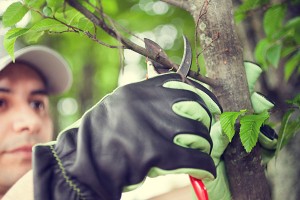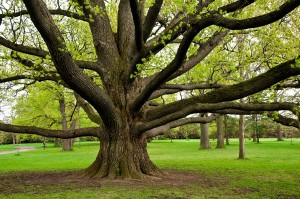How to Prune Trees
5 Tree Pruning Mistakes to Avoid

1: You routinely snip the tips of the branches to keep them in check.
Many people assume that lots of large cuts will hurt the tree, and that smaller cuts will be more gentle. In reality, cutting off the tip of the branches is one of the biggest pruning mistakes you can make. Pruning promotes growth, so when you cut back the branch, five or six new branches will quickly sprout in its place.
2: Your conifers grow like crazy in Summer, so you cut back the branches that get in your way.
Conifers can get so out of control in the growing season that they start reaching into the yard or onto your roof. Naturally, you want to remove the part of the limb that’s causing the problem but you end up leaving a noticeable stub. What you may not realize is that you’ve almost certainly killed that branch. New growth on a conifer is mostly derived from buds on the ends of branches that formed in the previous growth season. When you remove the bud, it usually results in a permanent stub that will always be brown and ugly.
3: You trim your weeping cherry tree like you’re giving it a bowl haircut.
Fighting against a tree’s natural shape is a never-ending battle. No matter how much you prune and trim, it’s guaranteed to keep growing where you think it shouldn’t. The worst part of it is, the more you shape your tree, the denser it will become, and it will eventually begin to die from the inside out.
4: A tree in the yard is too tall, so you chop off the top.
Many topping tragedies occur when we need to maintain a tree at a specific height or prevent it from growing too quickly. But, removing the top of a tree will cause several new leaders to replace it, similarly to the results of mistake number one. Those new leaders will compete with each other, eventually compromising the structural integrity of your tree. Ideally, a tree should have one dominant trunk in the center, allowing it to fare better in a storm.
5: You don’t prune at all.
This is probably the most common pruning mistake people make. Many are scared to make drastic cuts, fearing they will cut too much and set back growth or even kill the tree. While many others worry they will leave their trees looking misshapen and ugly. But, if you choose not to prune, don’t be surprised when your colorful trees and shrubs aren’t so colorful anymore as most species’ brightest hues come from new growth.
How Pruning Keeps Trees Healthy
Pruning removes weak branches that may become diseased. Once these branches are gone, the rest of the tree gains strength, fighting off sickness and harmful insects.
Branches require food, water and light. If a tree is overgrown, it won’t be able to get the nutrients it needs. Growth that’s too thick, blocks sunlight. Some parts of the tree may become frail because they are always in the shade.
Often a tree’s health will worsen gradually over the years. Regularly pruning away weak branches prevents diseases and insect pests from spreading. Trimming growth that’s too heavy lets air and light reach every part of the tree.
When to Prune Trees

Prune a Tree While It’s Dormant
The best time of year to prune your trees is when they are dormant, which is usually in the winter. This will allow for a spurt of new growth once spring returns and will encourage a fuller, more mature look for the tree as it continues to grow.
It’s best to wait until the coldest part of winter has passed. Pruning a tree in the middle of freezing weather can harm your tree. Harsh weather is a stressor and pruning during that time can overwhelm a plant.
What About Flowering Trees?
Some trees can benefit from spring pruning. If you have a tree that flowers in spring, pruning after the blooms fade will encourage more profuse flowering. Summer flowering trees can be attended to in winter or early spring.
Avoid Fall Pruning
It’s important to note that except to remove damaged limbs, you should not prune most trees during the autumn months. Fungi spreads most rapidly during fall, especially on trees that have recently been trimmed.
Pruning Young Trees
A newly planted tree often needs no pruning. A young tree is establishing roots and storing food. Pruning removes the leaves it needs to photosynthesize and get nutrition.
Once a tree is established, after about 2 years, it needs annual winter or early spring pruning. Shaping a tree while it’s young ensures it grows into an ideal shape. Use a sharp, clean bypass pruner to remove small branches. Cut at an angle, close to a node.
Here’s how to prune young trees:
- The first year: Remove broken branches. If the new tree has a second leader, or vertical stem at the top, remove the weaker one.
- The second and third year: Cut branches to give the tree shape and wind resistance. Remove branches that are growing toward the center of the tree. Remove branches that cross another branch, or crowd out light or air. In general, don’t remove more than about 25 percent of a tree’s size.
Shaping and Pruning Mature Trees
Shaping an Established Tree

The best time to perform annual pruning is when a tree is dormant in winter and early spring. It’s OK to trim during the growing season, but doing so will slow your tree’s growth. Remove dead or damaged branches as soon as you notice them, at any time of the year. Don’t hesitate to call Inexpensive Tree Care if you need help with a tree.
Here’s how to prune a tree that’s established but still young.
- Prune low limbs: Now’s the time to cut branches that could get in the way of traffic. If foot traffic will pass beneath the tree, remove branches lower than about 7 ½ feet. For vehicular traffic, you’ll need a clearance of around 11 feet.
- Remove crossing branches: Prune away branches that cross, rub together or are growing toward the trunk.
- Create airflow: If the canopy is too crowded the tree will suffer from poor air flow. Try to prune so branches are separated by about a foot.
- Don’t get carried away: Don’t remove more than about 25 percent of a tree’s canopy. If you keep up with yearly pruning, you won’t be faced with a tree that’s out of control. A mature tree is the work of many years; you’ll have a chance to prune more next year.
Technique for Pruning Mature Trees
Branches smaller than an inch can be removed with bypass cutters. Branches larger than this are too thick for cutters. Remove branches with a diameter up to 4-inches with a pruning saw using the following 3-step technique to protect the bark against tearing:
Cut just outside of a tree branch collar. The collar is the slight swelling where the base of a branch attaches to the tree. Cutting the collar slows the trees ability to heal. Here’s how to make a cut without tearing the bark of the tree:
- Make an undercut: About 6 inches out from the collar, cut from the bottom side of the branch about one-third of the way through.
- Remove the branch: Two inches farther from the trunk, cut from the top side of the branch all the way through.
- Cut off the stub: Remove the branch stub just beyond the collar. Don’t cut flush with the trunk.
Leave High Branches to the Pros

A chainsaw is the most efficient tool to remove branches thicker than about 4 inches in diameter. Once your tree gets this large, it’s best to call us. We’ll remove large, high branches safely. Your trees will stay healthier when they receive annual pruning.
Rely on Inexpensive Tree Care for Pacific Northwest Tree Pruning
Our skilled arborists help keep trees of any age healthy. If you have a large tree, please contact us at (503) 679-1410. We have the equipment and expertise to safely remove branches from tall trees.
A tree lives a long life when we nurture it. The trees in your yard could live decades with the proper care. As the old English proverb goes, “If you want to be happy for a year, plant a garden; If you want to be happy for life, plant a tree.”




